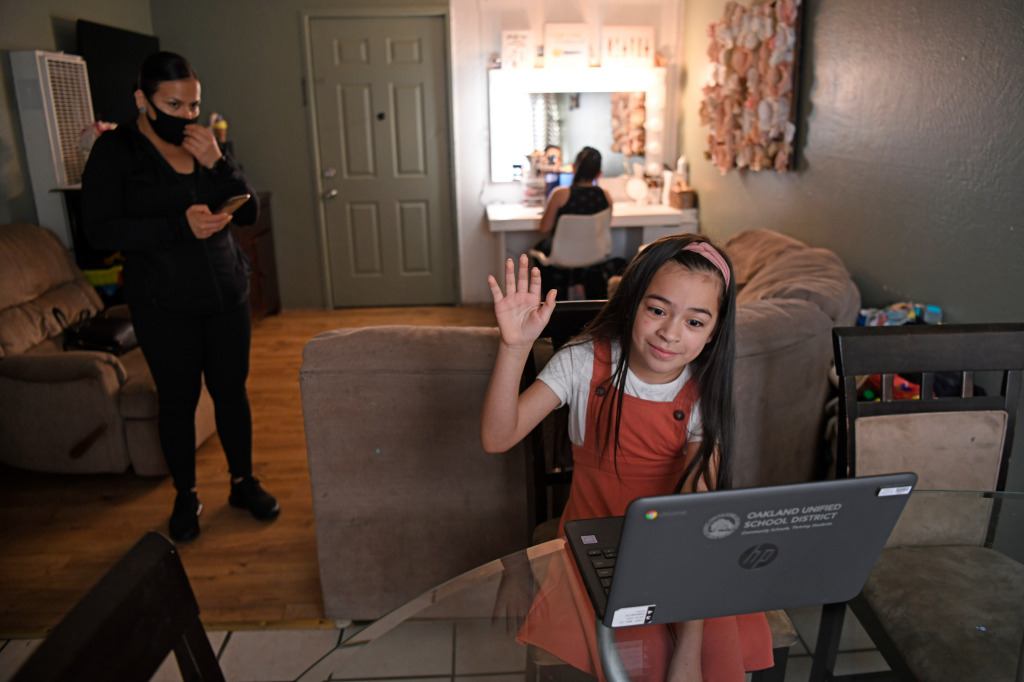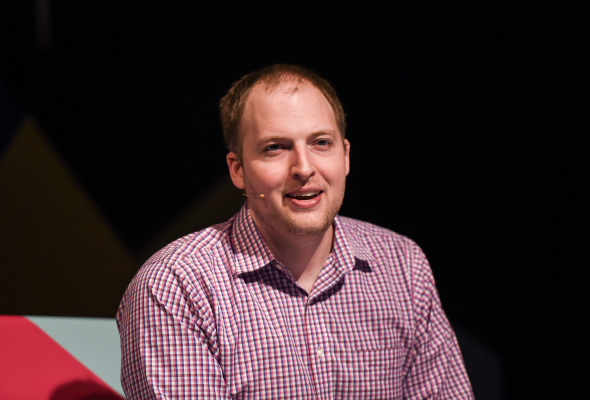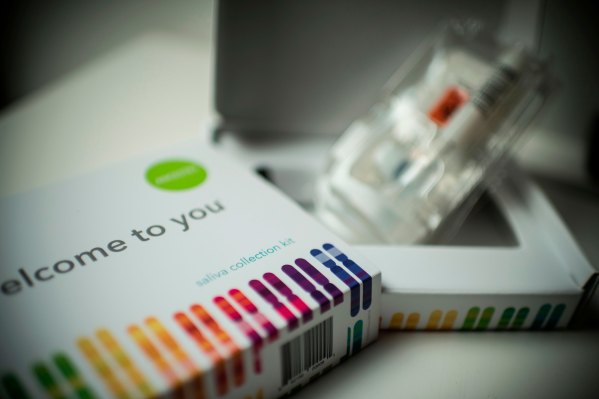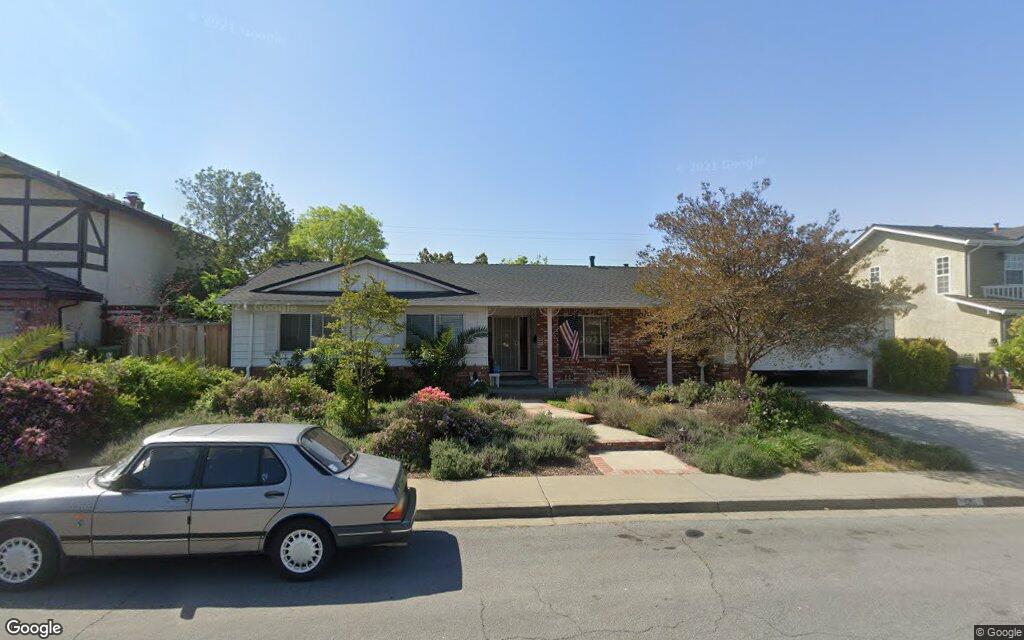Welcome to the second installment of our coronavirus year-in-review. (Part 1 was published yesterday.) We’re featuring more of the journalism that stands out after a year of coronavirus coverage. You’ll hear directly from our reporters and photojournalists about the stories that were especially meaningful to them.
Today, we’ll cover roughly the second half of the pandemic: from reopening debates about school and sports, to the winter holiday surge, to vaccines. Plus, we’ll highlight what we’re learning about the virus’s disparate impacts on vulnerable communities — and how we go forward from here.

As the summer ended and the fall began, the 49ers played their first game to an empty stadium, and families fled the Bay Area so their kids could play soccer. ••• For the most part, students were in virtual school. Online learning had improved since the spring, but virtual students still fell behind. ••• In those schools that did open, cases were low. ••• For some working parents, the only solution to online learning was to drop their job. ••• One middle schooler set up a “garage classroom” complete with desks and a lunchtime.
Darren Sabedra, high school sports reporter: Coronavirus and high school sports: A daughter’s loss, a parent’s pain, July 26, 2020
No matter who’s on the other end of my phone, one question is always asked: How’s your daughter? Few things have been harder for me as a dad and sportswriter this past year than watching my daughter’s senior year of high school — she plays water polo and swims — go sideways because of the pandemic.

Leonardo Castañeda, demographics reporter: Anxiety, tears and empty streets: How coronavirus exploded among Latinx residents in Oakland’s Fruitvale district, August 9, 2020
Reporting this story, I was struck by the strength and resiliency of Fruitvale’s residents, trying to survive at a time when it felt like the virus was spreading at will in their community. Underneath the case, death and unemployment numbers, there’s a single mother trying to feed her daughter while she watches her business crumble, or an essential worker who has to stop volunteering to clean his neighborhood because he tested positive for COVID-19.
By the fall, one out of every 100 businesses in the San Francisco metro area had permanently closed — gyms were hit especially hard. ••• For every job opening in San Francisco and San Jose, 11.4 people were searching for work. ••• Coronavirus layoffs sent middle-class workers to jobs with lower pay and higher risk, as people with doctorates applied to work at Safeway.
Joseph Geha, local reporter: Amid pandemic, Fremont continues using boulders to keep homeless, truckers away from Keto Road, October 5, 2020
The drastic inequities in the Bay Area are evidenced all around us. One of the constant struggles for local governments is deciding how to address homelessness. Stories like this help us pause and recognize there are real people who are affected by each of the policies we choose to support or oppose. This story gave me the opportunity to connect with people who have lived in our community for years, even decades, but who are often overlooked.

In November, election day came and went, with many choosing to vote by mail. ••• As the holidays approached, California recorded its millionth case. ••• Gov. Newsom apologized for his French Laundry dinner. ••• The virus surged, hospitals braced for impact and a curfew went into effect. ••• A second wave of infection struck nursing homes. ••• The public’s patience wore thin, even as we wondered if we were behaving “selfishly.” ••• Some Thanksgiving travelers took flight, while others made do with empty place settings, fewer sides and drive-by dinners; some ate their meals outside, or served the hungry. ••• Holiday travelers returned to new quarantine rules.
Cam Inman, San Francisco 49ers reporter: 49ers beat reporter Cam Inman shares his COVID-19 experience, November 22, 2020
2020 was a trying year that made all of us explore different journalistic avenues. I wrote about my battle with coronavirus in personal detail in an effort to help educate and prevent others from getting sick.
In December, things went from bad to worse, as “doom and gloom” returned to hospitals and the region locked down again. (Before it did, residents scrambled to visit Santa and pick up gifts.) ••• California topped 2 million cases, doubling its total in just six weeks. ••• There were still few drugs available to treat the virus. ••• In one hospital, nurses cut snowflakes and hung them on the windows, though their critically ill patients weren’t alert enough to notice. ••• Families spent time together on FaceTime, and one woman whipped up a pecan pie for one, though some still traveled for Christmas. ••• A well-meaning Kaiser staff member in a Christmas tree costume became a superspreader; at least 74 Kaiser employees and 15 patients were infected, and one staff member died.

Outside hospital walls, the pandemic continued to ravage the economy. One single mother lost all her jobs and fell behind on rent. ••• An audit showed the EDD was completely unprepared for the surge in jobless claims. ••• Small landlords struggled. ••• Food banks could barely keep up with demand. Along one line, volunteers carried jumper cables; some cars lined up so early their batteries would die. ••• At the same time, some remote workers experienced a “weird boom time,” commuters got their lives back, the rental market favored luxury seekers and entrepreneurs started new businesses, including a vegetarian Chinese restaurant.
Ethan Baron, business reporter: Silicon Valley’s million-dollar question: Does remote work kill innovation?, December 13, 2020
This story addressed an existential question for the Silicon Valley technology industry, and presented a remarkable consensus among experts and observers that the pandemic will lead to highly consequential and permanent changes in the way work gets done in this most famous of industries and regions.
In the new year, the post-holiday surge took shape, as California passed 3 million cases and doubled its previous monthly death record. ••• At home, health care workers faced fear: “Dad, are you going to die?” one child asked. ••• Crematories ran double shifts. At one mortuary, a worker made a daily ritual of laying a fresh flower on each body stored in the refrigerated parking lot trailers.

At the end of January, with cases again on the decline, the state lifted its stay-at-home order. ••• As pressure built on schools to reopen, we found that rich schools were more likely to offer in-person learning than poor ones. ••• Kids who returned found protective plastic shields and spaced-out desks. ••• Congregants returned to indoor sanctuaries. ••• Parents, coaches and student athletes organized “let them play” rallies, and by the end of February, football was once again allowed. ••• California recorded 50,000 deaths.
Linda Zavoral, assistant features editor: Legacy in a milkshake: Grieving Palo Alto family seeks donations for mom’s favorite diner, January 28, 2021
Over the past year, I’ve found the community support for struggling restaurants so heartwarming. When the Koyama daughters lost their mother to cancer, they thought long and hard about a tribute to her — and came up with the Palo Alto Creamery, where they had shared so many happy times. The fundraiser they launched in her memory has helped keep the staff employed and the milkshakes coming.
Paul Rogers, natural resources and environment reporter: How COVID changed Bay Area parks, February 14, 2021
The pandemic demonstrated the enormous value that parks play in people’s lives. Some counties like Santa Cruz tried to close beaches early on, but gave up because so many people refused to stay away. Yosemite’s closure and reopening made national news. Local and regional parks learned how to stay open, keep visitors safe, and keep nervous parks employees going — playing a vital role in helping us all get through a very difficult time.
By March, indoor sports like basketball and volleyball had the go-ahead. ••• Gov. Newsom signed a new school reopening bill to incentivize getting kids back into classrooms. ••• As counties enter the red and orange tiers, restaurants and gyms welcome back customers. ••• Outdoor stadiums and performance venues are set to reopen in April. ••• Even as case numbers decrease, troublesome new variants make our vaccination campaign even more urgent.

California got off to a stumbling start with its vaccination efforts beginning in mid-December, when the first Californians got coronavirus vaccines. ••• Websites crashed and phone lines clogged as people tried to make appointments; the uneven rollout caused cancellations and vacancies. The state is still struggling with supply shortages. ••• We explained side effects, immunity passports, and whether your boss can make you get a shot. ••• Farmworkers got their shots from a clinic at Monterey Mushrooms. ••• Good Samaritan Hospital stopped giving vaccines after a scandal involving Los Gatos teachers. ••• Outbreaks plus vaccination mean California’s jails may now be reaching herd immunity. ••• The state has committed 40% of vaccines to low-income communities, but Bay Area officials say many of our region’s hardest-hit zip codes were left out. ••• Now, counties are rejecting Blue Shield’s oversight. ••• We’re continuing to track who’s eligible for vaccination (a group that now includes transit workers, homeless individuals and people with “high-risk” conditions) and how to get a shot, whether at pharmacies or mass vaccination sites. ••• One in four California adults have received at least one vaccine dose. ••• And some seniors have celebrated their vaccinated freedom with margaritas and belly dancers.

Data has demonstrated the pandemic’s disproportionate impacts on vulnerable communities, often along racial or class lines. ••• This week, we took an in-depth, investigative look at how the Bay Area’s response failed Latino residents. ••• In San Mateo County, one community went from 10 coronavirus cases to 551 overnight. ••• Frustrated East San Jose residents formed their own task force when they saw their neighbors dying. ••• In Marin County, Spanish-language materials and contact tracing made a difference.
One year later, we’re reflecting on what we’ve lost and learned, and looking back at photos that tell the story of this difficult year. ••• Many people have left the Bay Area, and it’s not clear how long-lasting the exodus will be. ••• We’re learning more about what vaccinated people can do safely and storing up lessons for the next pandemic. ••• Most of all, we’re wondering when we’ll be able to declare victory over COVID-19.

Jane Tyska, photojournalist, March 18, 2021
I suspect it’ll take us years to recover from the psychological and social harm that the COVID-19 pandemic has caused. It’s so hard on everyone to be separated from their families, friends and community while fearing getting sick themselves.
I look forward to the day when venues for music, sports and worship fully open back up and people don’t avoid each other in the street. When we’re not afraid to shake hands, to high-five, to hug, to kiss. To embrace each other and feel human again.
Thanks for reading our stories this year. Be well.
This article first appeared in our Morning Report newsletter. Sign up for Morning Report and see our other newsletters here if you’re a MercuryNews.com reader or here if you’re an EastBayTimes.com reader.










